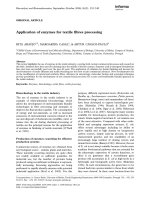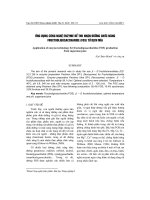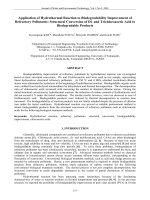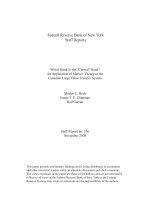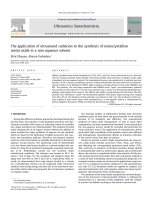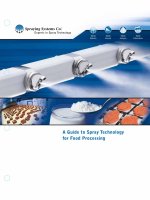Application of membrane technology to food process
Bạn đang xem bản rút gọn của tài liệu. Xem và tải ngay bản đầy đủ của tài liệu tại đây (724.74 KB, 6 trang )
<span class="text_page_counter">Trang 1</span><div class="page_container" data-page="1">
<b>Review </b>
<b>I </b>
Membrane technology is still evolving, finding more and II more applications in food processing. Conventional tech- niques such as micro- and ultrafiltration or reverse osmosis can now be regarded as more or less standard unit operations that are being implemented in numerous processes. Newer techniques such as pervaporation and bipolar membrane technology offer new possibilities, but are still in the process of development. The present trend of membrane technology in food processing is to produce more specialized membranes that are dedicated to one process, one product or even only to improving the quality of an existing product.
Ancient papyrus rolls suggest that centuries ago the Egyptians used a type of ceramic clay mesh for the clari- fication of wine I. These ceramic filters might be consid- ered as the first membranes used in food processing. The commercialization of membrane preparation and membrane processing originates from the beginning of the 20th century, when Zsigmondy in Germany began to manufacture microfilters. At that time, the filters were used only in laboratory-scale sterility tests rather than in industrial filtering devices. Nevertheless, the intro- duction of the microfilter marked the initiation of one of the largest modem membrane applications: the cold sterilization of numerous food and dairy process streams.
Membranes for use in large-scale commercial pro- cesses were not developed until the invention of the asymmetric membrane in the late 1950s. With this type of membrane, the high fluxes across the membrane that are essential for commercial applications were estab- lished. The first advantages to the tbod industry appeared quickly when reverse osmosis membranes were developed tbr purifying (desalting) water. From that time onwards membranes were introduced into sev- eral conventional processes (e.g. concentration by ultra- filtration instead of evaporation). Moreover, membranes permitted the development of entirely new processes and products (e.g. bioreactors with continuous product withdrawal, and desalted products).
The main advantages of using membranes in the food industry are summarized below 2.
• Membranes help to separate molecules and micro-
Undoubtedly, the first two points are the most signifi- cant. In principle, almost all separations currently prac-
<b>F. Pelrus Cuperus and Herry H. Nijhuis </b>are at the Agrotechnological Research Institute (ATO-DLO), PO Box 17, NL-6700 AA Wageningen, The Netherlands.
<b>Applications of </b>
<b>membrane technology to food processing </b>
<b>F. Petrus Cuperus and Herry H. Nijhuis </b>
tised in food and process technology can be achieved using conventional unit operations. For instance, steril- ization was traditionally achieved by thermal treatment. In cold sterilization, microfiltration is used to remove bacteria from products at low temperatures. The intro- duction of cold sterilization initially took place mainly in high-value markets (e.g. the pharmaceuticals industry) to prevent irreversible product damage due to thermal treatment. Cold sterilization has since become standard practice in food processing, since it both preserves prod- uct quality and avoids the introduction of off-flavours.
Membrane technology is still rapidly evolving and new processes are presently undergoing development 3. In 1991 the worldwide application of membrane tech- nology to food processing amounted to -US$40 million; this is expected to increase to US$230 million by 1997 (Ref. 4). These figures represent a steady 10% share of the total market for membranes.
A review of the applications of membrane technology to food processing indicates that the ultimate goal of the technology is changing, in the past, membrane technol- ogy research involved mainly the development of a membrane, its application to a process and the subse- quent manufacture of a product without much feedback to the first development stage. The present trend is towards more extensive integration of the processes of membrane preparation, membrane function and manu- facture of the desired product. This means that a mem- brane tends to be developed for a certain application, being specialized to apply to one particular product or even to improving the quality of that product. In recent years, a number of extensive reviews on membrane fil- tration in the food industry have been published 5"6. in this review the trend towards dedicated systems is illus- trated by describing a number of more or less estab- lished membrane applications in the food industry together with some new technical advances that appear to have great potential in the production of high-quality food.
<b>From sieving to dedicated separation </b>
There is an increasing tendency for membranes to be developed for one particular separation problem. The selection of the appropriate membrane is one of the key steps during process development, and frequently specific membrane preparation or modification is involved 3. A rough classification of membrane types 7
Trends in Food Science & Technology September 1993 [Vol. 4] Science Publi,,hers Lld. IUKI ()c124 -22441tI I/$(11,.0[I 277
</div><span class="text_page_counter">Trang 2</span><div class="page_container" data-page="2">can be made on the basis of the (molecular) size of the product to be separated, as is shown in Fig. 1. Nanofiltration, ultrafiltration and microfiltration involve separation mechanisms in porous membranes, while reverse osmosis and pervaporation make use of tight, dense membranes. Ultrafiltration and microfiltration membranes separate on the basis of a simple sieving me chrism.,. R e particle dimensions in relation to the pore size distribution of the membrane determines whether or not a particle can pass through the mem- brane.
Reverse osmosis and pervaporation are able to sep- arate species that have comparable sizes, such as sodium chloride and water, In such cases, the affinity between the membrane and the target component is important, as well as the velocity of the component permeating the membrane. Components that have greater affinity for the membrane material dissolve more easily in the membrane than other components; therefore, the mem- brane material acts as an extraction phase. Differences in the diffusion coefficients of the components across the membrane causes separation. According to the 'solution-diffusion' theory, solubility and diffusivity together determine the membrane selectivity 7. The way in which nanofiltration membranes work is not en- tirely clear. Possibly both size exclusion and solution- diffusion mechanisms play a role.
In electrodialysis, charged (ion exchange) membranes are used to separate molecules or ions in an electrical field on the basis of differences in charge and transport velocity through the membrane. Often, these mem- branes have very narrow pores ( I - 2 n m wide) and charged sites ". In an electrodialysis cell a number of cation and anion exchange membranes are placed between an anode and a cathode. When a current is
Different membrane processes separate different substances according to size (given in nm). ED, electrodialysis; Nanofiltr., nanofiltration;
PV, pervaporation; Re, reverse osmosis. (Taken from Ref. 7.)
applied, positively charged ions migrate through the cation exchange membrane while the negatively charged ions migrate through the positively charged anion exchange membrane. Some ion exchange mem- branes can even discriminate between monovalent and muitivalent ions, such as Mg 2÷ and Na ÷. The basic prin- ciple of electrodialysis is known as the 'Donnan ex- clusion principle' and can be described by equilibrium thermodynamics 9.
In contrast to the processes mentioned above, in which the membrane material is typically solid (mostly a polymer), liquid membranes consist of a thin liquid film that controls mass transfer and acts as a separation medium. Mass transfer can be facilitated by adding a special component that exerts a carrier function. This carrier can be very selective and, in principle, very ef- ficient membranes can be made. However, because of membrane stability problems, liquid membranes have so far been applied on only a very limited scale 7.1°.
There is some overlap in the applications of different membrane types. For instance, reverse osmosis and electrodialysis can both be used in the preparation of potable water. In such cases, other factors besides the membrane characteristics are important in the selection of a membrane process <small>TM </small>~. Some of these considerations are discussed below.
<b>Decisive engineering parameters </b>
In principle, all membranes can be regarded as selec- tive sieves that are more permeable for certain (target) compounds than for others. This means that on a mol- ecular level, in the direct proximity of the membrane, a build-up in the concentration of the retained molecules occurs. This phenomenon is called concentration polar- ization. The retained, accumulated (but still dissolved) molecules are an additional resistance to solvent per- meation. The direct consequence of this fully reversible concentration polarization is a resistance that arises from the osmotic pressure, which leads to a decrease in the driving forcC-'. However, the solute concentration, especially of proteins, near the membrane interface <b><small>c a n </small></b>
reach such high values that gel layer formation occurs. Gel layer formation is usually referred to as 'membrane fouling' and is irreversible or, at best, only partly reversible. Membrane fouling can also be caused by other
<i>phenomena, </i>
such as the adsorption of proteins and plugging of pores (see Fig. 2). Hence, a reversible and direct decline in flux across the membrane might be defined as concentration polarization, whereas irre- versible and long-term decline in flux are termed mem- brane fouling. Both generally occur in every membrane process, but the effects are most dominant in micro- filtration, ultrafiitration and reverse osmosis 12,~3, and sometimes in pervaporation ~4.Although concentration polarization and membrane fouling are inevitable in membrane processes, their detrimental effects can be reduced. Extensive studies describing both of these phenomena have led to improvements in membrane configurations, new modules, optimization of fluid dynamics and spacer
278
Trends in Food Science & Technology September 1993 IVol. 41
</div><span class="text_page_counter">Trang 3</span><div class="page_container" data-page="3">development. Spacers are open structures separating stacked membranes in spiral wound and plate-and-frame modules. Materials and structures have been developed that promote turbulence, thus reducing concentration polarization and membrane fouling. However, despite these advances, concentration polarization and fouling are still problematic, although some innovations to prevent fouling are practised ~s.
The first membrane filtration setups were used in the dead-end mode (Fig. 3a). This kind of classic filtration allows liquid to pass while retaining the target com- pounds. With this technique severe fouling and concen- tration polarization (sometimes accompanied by cake formation) can occur, leading to an extremely large decline in flux and inefficient processing. Although dead-end filtration is a very simple operation, in practi- cally all processes the cross-flow filtration principle (Fig. 3b) is currently used. In this technique the feed is pumped parallel to the membrane surface, thus dimin- ishing the thickness of the hydraulic stagnant layer and decreasing the tendency towards concentration polariz- ation and fouling. Cross-flow filtration is often used in combination with a backflushing procedure, whereby the filtration flow is reversed for a short period of time so that stationary concentration polarization profiles are disturbed and obstinate particles are removed from the
membrane surface 16. The cross-flow velocity, trans- membrane pressure and backflush frequency are the im- portant process parameters that are normally tuned to the optimum for low fouling, high flux and low energy costs. Dead-end microfiltration has been practised for many years because, compared with normal filtration, the high pressures used render reasonably good fluxes. However, detailed studies have indicated that low press- ures (~100 kPa) and cross-flow velocities of 3-5 m/s can lead to more econon,eal and reliable processing ~7. Although the driving force for filtration is low in
<b>these </b>cases, fouling and concentration polarization are decreased. Therefore, installing a greater membrane area is more beneficial than increasing the feed pressure.
An interesting new approach for the control of fouling has been developed by Van Boxtel 's. A 'self-learning' mathematical model estimates the characteristic process dynamics of the system t2"~ring the first 15 minutes of operation. Using these characteristics, process par- ameters are then regulated throughout the rest of the process. Van Boxtel has demonstrated that, using this approach, the reverse osmosis of cheese whey can be optimized to yield 10% more cash flow with 20% lower energy costs.
<b>The evolution of membrane processes </b>
Table 1 lists some of the membrane processes used in
<i>food processing. The dairy industry has accepted and </i>
developed membrane processing quite extensively. A certain trend from 'technology push' to 'product pull' can be seen. Previously, membranes were simple sieves that were bought and accepted as they were, whereas
now systems are specially designed to manufacture a
Membrane fouling may be caused by the adsorption of proteins or by pore blocking. Concentration polarization may also lead to membrane fouling if the solute concentration near the membrane interface becomes too high, leading to formation of a gel layer.
certain product ~9.2°. The production of dried egg-white protein is an example of how membrane technology has evolved (Fig. 4). In the conventional process, the pro- tein was concentrated using a vacuum oven, which is rather time consuming and expensive. Although for a completely dry product a final heating stage is still necess- ary, the incorporation of a membrane unit for concen- trating the protein (to a purity of 50-60%) before heat- ing diminishes costs and increases throughput. With the membrane it is impossible to concentrate the protein by more than 60% because viscosity, and hence pressure drop, becomes too high. Another example from the dairy industry is the production of 'Quark'. In the orig- inal process the curds that formed in the reactor were concentrated by means of a centrifuge, which resulted in
Dead-end filtration (a) compared with cross-flow filtration (b). The detrimental effect of concentration polarization and fouling is greater in dead-end filtration than in cross-flow filtration, which breaks up accumulating retentate. The diagrams on the right-hand side show that by using backflushing to restore flux, the cross-flow technique is made even more efficient.
</div><span class="text_page_counter">Trang 4</span><div class="page_container" data-page="4"><b>Table 1. Examples of membrane operations in food processing </b>
Pl1~e~ or
<b>application Typical product </b>
Cold sterilization Beer, wine, milk Clarification Wine, beer,
Fractionation Proteins (egg, OF whey, blood), carbohydrates
Product recovery Lactic acid, UF, ED citric acid
Product improvement Aromas, flavours PV, RO
ED, electrodialysis; MF, microfiltration; NF, nanofiltration; PV, pervaporation; RO, reverse osmosis; UF, ultrafiltration
A membrane process for producing protein flakes from dried egg white. Ultrafiltration concentrates the protein before it is dried.
Outline of a process for the production of clarified fruit juice. The recovery of aroma compounds is established using reverse osmosis membranes.
a considerable loss of protein. The application of an ultrafiltration membrane prevents this loss and yields a more tasty product.
The improvement of the organoleptic properties of foods is also an important motive for using membrane processes in sterilization and clarification. However, selective extraction is difficult due to the complexity of the mixtures usually involved. Therefore, highly selec- tive membranes are essential. For instance, during the dealcoholization of beer and wine, aroma compounds may be removed along with the alcohol. Recovery of the flavour compounds from the alcohol by cooling and subsequent recycling of the aromas may be successful, but makes the process more costly 2t-23.
Recently, membranes have been developed for the recovery of taste and odour compounds. Reverse os- mosis is used to extract the vital components from the aqueous (or vapour) stream that is produced by the con- centrater unit (e.g. a reverse osmosis or ultrafiltration unit)2L A typical example of such a process is shown in Fig. 5. The concentrated flavour extract may be either added to the concentrated fruit juice or used in bever- ages or other food products. Pervaporation or vapour permeation is a good alternative to reverse osmosis in recovering aroma compounds (see Refs 22, 23). The feasibility of using pervaporation to recover the mushroom flavour I-octen-3-ol from biotechnological processes has been assessed by Voilley <i>et ai. 24 </i>A high- boiling lactone (6-pentyl-(z-pyrone) produced by the fungus <i>Tric'hoderma virMe </i> was extracted from a fer- menter 25, and a product enrichment of 10-20% was established using homogeneous organophilic polyether- polyamide copolymer membranes.
The interest in electrodialysis as a membrane process has been triggered by recent developments in membrane materials2'"~'--'L These new materials offer better stability and performance, thus giving scope for new appli- cations. Large-scale applications of electrodialysis can be found in the desalination of whey used in ice cream, bread, cake, sauces and baby food 2'J. Electrodialysis is preferable to reverse osmosis since it does not affect taste, colour or flavour. Also, the desalting of species of high molecular mass is very effective and the process can be very precisely controlled. Major disadvantages of electrodialysis are the high operation costs and the susceptibility to fouling 3°. Protein separations have been achieved by adjusting the pH of the protein of interest to its isoelectric point during electrodialysis of the treated solution. The uncharged protein does not move in the electric field, whereas the salts migrate according to their electrical charge. Using this method, the solution is desalted with minimal loss of the solute3~-~.k
Another recent breakthrough is the so-called bipolar membrane 2'-'~'-u. Bipolar membranes can be used in water-splitting processes, and offer possibilities for the recovery of organic and amino acids. Bipolar mem- branes allow a salt to be split into the corresponding alkaline and acidic solutions. An example of applying a bipolar membrane in combination with electrodialysis is
</div><span class="text_page_counter">Trang 5</span><div class="page_container" data-page="5">Outline of the use of electrodialysis and a bipolar membrane to produce lactic acid from a sodium lactate solution produced by a fermenter. The negatively charged lactate migrates through the anion exchange membrane and recombines with the H* ion generated by the bipolar membrane. Sodium hydroxide is the by-product formed by combination of the residual ions.
shown in Fig, 6. A sodium lactate solution from a fer- menter is fed into an electrodialysis - bipolar membrane unit. The negatively charged lactate migrates through the anion exchange membrane and recombines with the H ÷ ion generated by the bipolar membrane 34. The prin- ciple illustrated in Fig. 6 can be adapted to fit different applications, which all have their own positive and nega- tive features. This technology has good prospects for the near future.
The integration of membranes and reactors has led to very effective production systems 34"3-s. An example is the enzyme-mediated esterification process that is used for the production of esters, such as flavour molecules or glycolipids. Water plays a very important role in this type of conversion. It influences the reactivity of the bio- catalyst and interferes with the thermodynamic equilib- rium of the reaction. Normally, conversions occur with an efficiency of 40-50%; to achieve higher conversions the water produced during the reaction must. be r(~movad from the reactor. A pervaporation membrane has been shown to be very effective in achieving this, and enhances the conversion rate to 95% or higher -~6.
Studies on the recovery of organic acids (e.g. formic, acetic and butyric acids) from fermentation beers using liquid membranes have been reported in Japan 37. Others studied the removal of citric acid or sodium citrate from fermentation broths using liquid membranes -as . Economic analysis of the process showed that it could recover
citrate at half its market price. A problem with the extremely selective liquid membranes is that they are not stable enough for long-term use. Therefore, despite their potential, they have so far been used rarely in industrial processes.
<b>Conclusions </b>
Membrane technology is increasingly used in food processing. Early applications such as the cold steriliz- ation and filtering of fermentation broths were reason- ably simple and used standard membranes. Currently, however, membranes and membrane processes are developed in conjunction with the ultimate product. Essentially this means that membrane technology is focusing more and more on specialty products. It also suggests that membrane developers and membrane users should communicate with each other even more than they have done in the past.
<b>References </b>
<i>1 Gelman, C. (1965) Anal. Chem. 37, 29 </i>
<i>2 Strathman, H. (1992) Recent. Prog. Genie Proc~d~s 21(6), 17 3 Lonsdale, H.K. (1982) J. Membrane Sci. 10, 81 </i>
<i>4 Crull, A. (1993) Membrane Sep. Technol. News 11(6}, 12 5 Kosikowski, F.V. (1986) in Separations in Biotechnology </i>
(McGregor, W.C., ed.), pp. 201-254, Marcel Dekker
<i>6 Chervan, M. 1i986) Ultrafiltration Handbook, Technomic 7 Muider, M.H.V. (1991) Basic Principles of Membrane Technology, </i>
Kluwer Academic
Trends in Food Science & Technology September 1993 [Vol. 41 281
</div><span class="text_page_counter">Trang 6</span><div class="page_container" data-page="6">8 Hsu, W.Y., Barkley, J.R and Meakin, J. (lqgfl) <i>Marmmol~cules 13, </i>
1264
9 Helfferich, F. (1962) <i>Ion.Exchange, McGraw Hill </i>
10 Baker, R.W. and Strathmann, H. (1991) <i>Membrane Separation Systems: Recent Developments and Future Directions, p. 242, Noyes Data </i>
Corp., NJ, USA
11 Davis, T.A. <i>(1992) Proceedings lOth Annual Membrane Technology Planning Conference, Business Communications, Norwalk, CT, USA </i>
12 VandenBerg, G.B. and Smolders, C.A. (1988) <i>Filtr. Sep. March/April, </i>
155
13 Jonsson, G, (1984) <i>Desalination 51, 61 </i>
141, Nijhuis, H.H., Mulder, M.H.V. and Smolders, C.A. (1991) <i>J. Membr. Sci. 61, 99 </i>
15 Strathmann, H. (1990) in <i>Effective Industrial Membrane Processes: Benefits and Opportunities (Turner, M.K., ed.), p. 1, Elsevier </i>
16 Belfort, G. and Altena, F.W. (1983) <i>Desalination 47, 105 </i>
17 Roesink, H.D.W. (I992) <i>Proceedings 10thAnnualMembrane Technology Planning Conference, Business Communications, Norwalk, </i>
CT, USA
18 Van Boxtel, A.J.B. (1992) <i>J. Membr. ScL 65, 277 </i>
19 Van der Horst, H.C. and Haanemaaijer, I.H. (1990) <i>Desalination 77, </i>
232
20 Glover, F.A. (1985) <i>Technical Bulletin 5, National Institute R&D, </i>
Reading, UK
21 Walker, ].B. (1990) in <i>Proceedings International Conference on Membranes, p. 283, Chicago, IL, USA </i>
22 Karlsson, H.O.E. and Tragardh, G. (1993) J. <i>Membr. ScL 76, 121 </i>
23 Merry, A.I. (1990) in <i>Proceedings International Conference on Membranes ICOM '90, p. 279, Chicago, IL, USA </i>
24 Voilley, A., Charhit, G. and Gohert, F. (1990) <i>.I. Food Sd 5, </i>
1399
25 Benglsson, G., B6deker, K.W., Brockmann, V. and Hanssen, H.P. (1992) in <i>Proceedings of the 7th International Conference on Pervaporation Processes, p. 430, Bakish Materials Corp., Englewood, </i>
28 Reed, P.B. (1984) <i>Chem. Eng. Prog. December, 47 </i>
29 Glassner, D. (1992) <i>Proceedings lOth Annual Membrane Technology Planning Conference, Business Communications, Norwalk, CT, USA </i>
30 VanNispen, J.G.M. (1991) US Patent 5 002 881
31 Gavach, C., Sandeaux, R. and Sandeaux, J. (1990) in <i>Proceedings International Conference on Membranes ICOM "90, p. 870, Chicago, </i>
IL, USA
32 Saeki, M., Kaneko, T. and Kawakita, T. (1983) Japanese Patent 83/251036
33 Czytko, M. (1989) US Patent 4 882 277 34 Glassner, D. (1990) European Patent EP 393 818 35 Drioli, E. (1992) <i>Recent. Prog. Genie Precedes 21(5), 20 </i>
36 Nijhuis, H.H., Kemperman, A., Derksen, J.T.P. and Cuperus, F.P. (1992) in <i>Proceedings of the 7th International Conference on Pervaporation Processes, p. 317, Bakish Materials Corp., Englewood, </i>
<b>readers for articles on new and developing areas in the field. A brief synopsis of the proposal should be sent to the Editor, who can provide more detailed information on the preparation of manuscripts. </b>
<b>Ideas are welcome for the following types of article: </b>
<b>Reviews focus on specific areas of food research that are developing rapidly, or that are considered to be in need of re-review due to changing priorities within the food industry. For this reason they are shorter and more focused than reviews in conventional review journals. Viewpoints allow the expression of personal opinions, observations or hypotheses on controversial issues, to provide new perspectives and to help advance understanding by provoking debate and comment. </b>
community.
<b>Conference Reports describe and assess the important points presented at relevant conferences worldwide. </b>
<b>All submitted material, with the exception of letters to the Editor, book reviews and conference reports, will be subject to editorial and independent peer review. </b>
282 <sub>Trends in Food Science & Technology September 1993 IVol. 4] </sub>
</div>